Da
- dack
- 1 trousers
- A contraction of dacron, the crease resistant synthetic material they were made from.
-
generic use of a trademark
- 2 to pull someone's pants down
- I was dacked in front of everyone.
-
since the 1960s

- dad & dave
- a shave
- After the two comical characters created by Steele Rudd in the late 19th century. Sometimes used to mean grave.
rhyming slang: dad and dave for shave
- dag
- 1 a character
- Someone eccentric but entertainingly so.
first recorded in 1916

2 a socially awkward person, usually an adolescent- Someone who doesn’t buy into fashion and is hopelessly resigned to being themselves.
popular since the 1960s

3 a lump of excrement-matted wool on a sheep's rear- The word was originally daglock, from a British dialect.
borrowed into aussie english in the 1870s

- Commonly used in the phrase rattle your dags.
first recorded in the 1980s

- daggy
- out of fashion, uncool
- I'm wearing my old dacks–they're not too daggy, are they?
- dags
- comfortable old clothes
- Usually worn around the house.
- dagwood dog
- a battered sausage fried on a stick
- Also called a pluto pup, or in SA, a dippy dog.
- dam
- an artificial pond with earth walls
- A classic australianism.
Outside Australia it refers only to the wall. - damages
- cost or expense
- damper
- a kind of bread
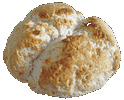 Traditionally baked in the ashes of a camp-fire, served with a mug of billy tea.
Traditionally baked in the ashes of a camp-fire, served with a mug of billy tea.first recorded in the 1820s

- dandy
- a container of an individual serving of ice-cream

Used in SA, elsewhere known as a dixie.sa slang

- dardy
- something cool
- Originating from south-west WA Indigenous peoples.
This word has been adopted by non-Indigenous Australian teens, particularly in the skateboarding subculture.
Many Australian teens also use the word to describe something worth buying. south-west wa indigenous nation

- Dapto briefcase
- a cask of wine
- Used in Wollongong NSW, after the township of Dapto.
Also called a Bellambi handbag. nsw slang

- darl
- darling
- Also in the form: Hurry up darls, we'll be late!
since the 1930s

- Darwin rig
- mens' formal dress in the top end
- Essentially there is no need for a jacket. The collar and tie is replaced with an open-necked shirt, long trousers are replaced with shorts and long white socks. Stubbies and t‑shirts are out.In recent years standards have been more relaxed. It may now incorporate thongs as footwear but they must be high quality ‘double pluggers’.
Also called a territory rig. nt slang

- Darwin stubby
- an exceptionally large bottle of beer
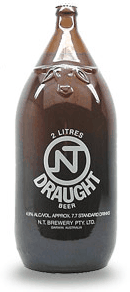 Created by Carlton United Breweries (CUB) when it began brewing NT Draught in 1957.
Created by Carlton United Breweries (CUB) when it began brewing NT Draught in 1957.
While more recently made Darwin stubbies hold a mere two litres of beer, they originally held the equivalent of six regular-size stubbies. The oversize bottle was used because of the logistics of shipping bottles large distances.
In May 2015 CUB announced that they will no longer brew NT Draught on a regular basis.nt

- date
- anus
- David Murrays ∼ no David Murrays
- no worries
- From a well-known furniture store in Adelaide.
sa rhyming slang

- Dawn Service
- a commemorative ceremony
- Held at dawn on Anzac Day, April 25.
It is the anniversary of the landing at Gallipoli of the ANZAC troops in 1915. first recorded in the 1920s

De
- dead horse
- tomato sauce
rhyming slang: dead horse for sauce
- deadly
- excellent, fantastic, cool
- Deadly is used by many Aboriginal people to mean excellent, or very good, in the same way that wicked is by many young English speakers. She was a deadly spunk in an even deadlier skirt. The word has crossed-over into the speech of non-indigenous adolescents, especially in the Northern Territory.
aboriginal english slang since the 1980s
The Deadlys began as an informal celebration and awards night for Indigenous musicians and broadcasters held in 1995, to mark the first 12 months of broadcasting for Indigenous music radio program, Deadly Sounds. In June 2014, the funding was cut by the Abbott Government, with funding phased back to $1 million and no funding provided for future years.In November 2017, the National Dreamtime Awards were launched to fill the void in recognising indigenous achievements as a result of the cessation of the Deadly Awards.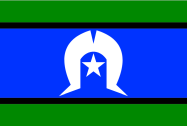

- deadly treadly
- a bicycle
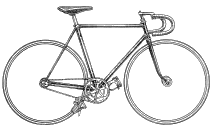 Lacking in accessories such as brakes, lights, etcetera.
Lacking in accessories such as brakes, lights, etcetera.ocker slang
- dead set
- 1 without a doubt
- I'm dead set against it
2 totally, utterly - He's a dead set nong.
3 honestly, fair dinkum - Dead set!
- deadshit
- an annoying person
- dead'un
- a horse that is deliberately run to lose
racing slang
- dekko
- a close look
- Originally British army slang from India, from the Hindi dekho.
since the 1950s

- deli
- a delicatessen
- In SA, WA, Qld, and elsewhere a deli is a milk bar or corner store, rather than a shop selling expensive food items.
since the 1970s

- der
- a mocking exclamation indicating stupidity
- Representing the natural exclamation of a brainless person attempting to think.
a der brain is a fool or an idiot. since the 1970s

- dero ∼ derro
- a person without a home, job, or property
since the 1960s

- desert art
- a style of modern australian aboriginal art
- Originating at Papunya, NT in the early 1970s.
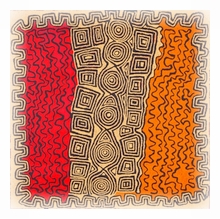
Also known as Papunya Tula.  aboriginal australia
aboriginal australia
Di
- dial
- the face
- dice
- to throw away, discard, reject
- The bookie diced his sheets when he saw the copper approaching.
- dick daks ∼ dick togs
- a brief men's swimming costume
- See speedos for a full set of synonyms.
- dickhead
- an unpleasant or despicable person
- A term of abuse, mainly used when the dickhead himself is absent.
- didgeridoo
- the oldest wind instrument on the planet
There are numerous names for the instrument among the Indigenous peoples of northern Australia, none of which closely resemble the word didgeridoo. In everyday conversation bilingual Aboriginal people will often use the word interchangeably with the instrument's name in their own language, for example yidaki in Yolgnu languageIt has been suggested that this must be a borrowing from an Aboriginal language, but it is not. The name evolved from white people's ad hoc imitation of the sound of the instrument.
- dig
- 1 an innings in cricket
- 2 a cutting or sarcastic remark
- digger
- 1 any australian soldier
- Originally a goldminer, then applied to soldiers from WWII.
- 2 a form of casual address
- Especially to older men, often abbreviated to Dig
- digger hat
- australian military headdress
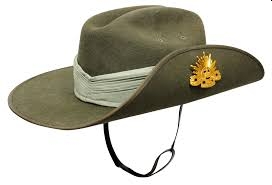 Since its inception more than a century ago, the slouch hat has become one of the most distinctive and defining items of Australian clothing. It is made with rabbit-fur or wool felt and has one side of the brim pinned to the side.It has been suggested the pinning made it easier to sling a rifle over the soldier. While that may have been the case, other countries never felt the need to pin one side of their hats to the side in order to sling a rifle over the shoulder. In other words, although the need to sling a rifle over a shoulder was not unique to Australia, no other countries decided to have their soldiers wearing the hat in such a way.Perhaps the Australian soldiers pinned the hat because they put pragmatism over style. Alternatively, military commanders might have encouraged the hat to be pinned because it distinguished Australian soldiers from other soldiers in British allied forces. This distinguishment helped build a unique social identity of the Australian soldiers, which was good for morale.
Since its inception more than a century ago, the slouch hat has become one of the most distinctive and defining items of Australian clothing. It is made with rabbit-fur or wool felt and has one side of the brim pinned to the side.It has been suggested the pinning made it easier to sling a rifle over the soldier. While that may have been the case, other countries never felt the need to pin one side of their hats to the side in order to sling a rifle over the shoulder. In other words, although the need to sling a rifle over a shoulder was not unique to Australia, no other countries decided to have their soldiers wearing the hat in such a way.Perhaps the Australian soldiers pinned the hat because they put pragmatism over style. Alternatively, military commanders might have encouraged the hat to be pinned because it distinguished Australian soldiers from other soldiers in British allied forces. This distinguishment helped build a unique social identity of the Australian soldiers, which was good for morale.australian military

- dill
- a fool or simpleton
since the 1940s

- dilly bag
- a small handwoven bag
- Hence, a toiletries bag or similar.
from the aboriginal language yagara, of the brisbane region

- ding
- a dent
- Especially in a car panel or surfboard.
- dingbat
- an eccentric, peculiar, or stupid person
- A mild insult, originally US slang from the 1870s.
since the 1910s

- ding-dong
- 1 a strenuously contested fight
- There's a ding-dong behind the pub!
2 powerful - I've got a ding-dong headache…
- dingo
- the native dog
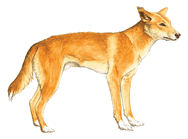 A wild dog, Canis lupus dingo, brought to Australia about 4000 years ago by Indonesian seafarers. Usually tawny-yellow in colour, with erect ears, a bushy tail and distinctive gait, and with a call resembling a howl or yelp rather than a bark. Linguists think that the term dingo was only used for the domesticated, camp dog.
A wild dog, Canis lupus dingo, brought to Australia about 4000 years ago by Indonesian seafarers. Usually tawny-yellow in colour, with erect ears, a bushy tail and distinctive gait, and with a call resembling a howl or yelp rather than a bark. Linguists think that the term dingo was only used for the domesticated, camp dog.
See warrigal for the wild animal.- 1 a threat to australias prosperity
- A menace to pastoralists, to be trapped, shot, or poisoned at every opportunity; an animal detested by all, with a bounty on his head.
2 a coward - Any cowardly human, who refuses to face his responsibilties or his opponents, is a dingo.
To turn dingo on someone is to betray them. since the 1860s

- dingo's breakfast
- a piss and a good look around
- In other words, no breakfast at all.
Also called a bushman's breakfast. - dink
- to carry a second person
- On a bicycle or horse.
Same meaning as barie - dinkum
- genuine, true
- A dinkum aussie
Appeared first in the phrase fair dinkum in 1881 in Britain, in 1890 in Australia, and as a separate word dinkum, from 1905.
From Derbyshire and Lincolnshire dialects, meaning work or due share of work.
Altered variously to dink, true-dinks, and dinky-di. since 1905

- dinky
- of small size, dainty
- dip out
- 1 to opt out or not join in
- Sorry, I'll have to dip out of the next beer.
2 to miss out on an opportunity - I waited for the free lunch, but dipped out.
3 to fail - Johnno dipped out in the first round.
- dipstick
- a loser, an idiot
- dip your lid
- to lift your hat as a mark of respect
- Hence, to show admiration, as in I dips me lid.
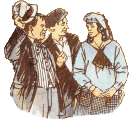 An allusion to the Sentimental Bloke by C.J. Dennis who dips his lid upon first meeting his lady-love Doreen.
An allusion to the Sentimental Bloke by C.J. Dennis who dips his lid upon first meeting his lady-love Doreen.the sentimental bloke was published in 1915
- dirty
- 1 angry, seething
- He was dirty on me for not inviting him.
since the 1960s

2 to betray or cheat- He did the dirty on me.
british slang since the 1910s

3 as emphasis- A dirty big black snake.
ocker slang

- dishlicker
- a racing greyhound
- Or any dog.
- divvy
- 1 a dividend, payout, or collect
- 2 a portion of profits
- Hence, to divvy up means to share out.
- divvy van
- a police van
 For conveying persons in custody.
For conveying persons in custody.
So called because of the dividing section which separates the police from the prisoners.- dixie
- a container of an individual serving of ice-cream
 Known as a dandy in SA.
Known as a dandy in SA.
Do
- do
- 1 a festivity or party
- We're having a big do next week.
2 to injure - He did his ankle jumping from the train.
3 to spend all your money - He did his dough at the races.
4 to be admirable - Used as a compliment or statement of phrase, as in
You'll do, mate! or How about that fullback? He'll do me!
5 to assault or beat up - As in the term do over. Originally a Kiwi term from the 1860s.
since the 1940s

- do a Melba
- to return from retirement multiple times
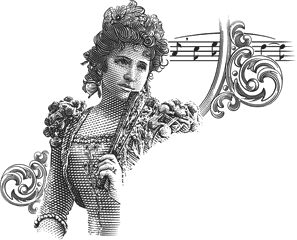
Alluding to the opera singer Dame Nellie Melba, who famously gave a number of farewell performances.- dob
- 1 to inform on
- A cardinal sin. Aussies are noted for a deep-seated reluctance to report any fellow citizen to anyone in a position of authority. Police, bosses, foremen, wives, etc, must do their own detecting.
Hence, a dobber is a telltale or informer.
2 to contribute funds to a collection - I dobbed in twenty dollars for her present.
since the 1950s

- doctor
- a cool southerly sea breeze
- One that blows after a hot day in the south-west of WA.
In Perth it is known as the Freemantle Doctor. - dodger
- 1 bread
- 2 an advertising leaflet
since the 1890s

- dodgy
- 1 suspicious, underhand
- He's one of those dodgy salesmen.
2 unstable, unreliable - Those foundations look a bit dodgy.
- doer
- a hard and keen worker
- A terms of respect, the opposite of a bludger.
since the 1900s

- dog
- 1 an informer
- 2 a prison warder
underworld slang
- dog & bone
- telephone
rhyming slang: dog & bone for phone
- dog fence
- the longest continuous barrier on earth
- Also called the dingo fence, it keeps these predators in the north away from sheep country in the south. It stretches 5,614 kms from Jimbour on the Darling Downs, ending above the Great Australian Bight near Nundroo.
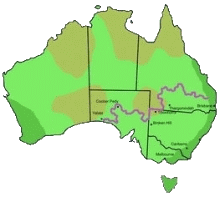 It is a pest-exclusion fence that was built to keep dingoes out of the relatively fertile south-east part of the continent (where they had largely been exterminated) and protect the sheep flocks of southern Qld.Although the fence has helped reduce the loss of sheep to predators, the exclusion of dingoes has allowed for increased pasture competition from rabbits, kangaroos and emus. Sheep are also being lost to increasing numbers of feral dogs.See rabbit‑proof fence for a similar fence.
It is a pest-exclusion fence that was built to keep dingoes out of the relatively fertile south-east part of the continent (where they had largely been exterminated) and protect the sheep flocks of southern Qld.Although the fence has helped reduce the loss of sheep to predators, the exclusion of dingoes has allowed for increased pasture competition from rabbits, kangaroos and emus. Sheep are also being lost to increasing numbers of feral dogs.See rabbit‑proof fence for a similar fence. constructed during the 1880s

- dog's eye
- a meat pie
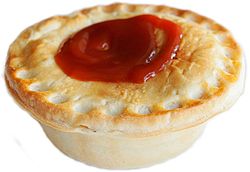
rhyming slang since the 1950s: dog's eye for pie
- dog's balls
- something obvious
- It sticks out like dog's balls!
- dog's breakfast
- a mess
- dog tied up
- an unpaid debt
since 1905
- dole
- social security benefits for an unemployed person
- dole bludger
- a derisive term for an unemployed person
 Especially one who does not make an attempt to find work.
Especially one who does not make an attempt to find work.
See bludger for more.since the 1970s

- do like a dinner
- to vanquish
since the 1840s

- dolled up
- dressed attractively
- dong
- to hit or punch
- I donged him on the head.
since the 1910s

- donga
- a temporary dwelling
- Hence, a demountable building, especially in a mining area.
- donkey vote
- a stupid vote
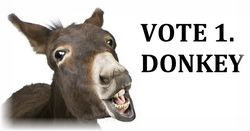 In a parliamentary election, voters numerically rank each candidate in order of preference.
In a parliamentary election, voters numerically rank each candidate in order of preference.
Voters who merely number the candidates in the order they are listed on the ballot paper (without regard for the merits of the candidates) are said to be casting a donkey vote.since 1962
- donkey-lick
- to defeat with ease
since the 1890s

- donk
- the engine in a car , boat , etcetera
- doona
- a quilted bedspread
- Originally a trademark, now used generically.
Elsewhere called a duvet.
a doona day is a kind of sanctioned sickie when you slop about the house in pyjamas and snuggle up on the couch with your doona. - doover
- a utility term for anything
- Originally Aussie military slang from World War I.
Also expanded to dooverlackie. - do the bolt
- to run away or abscond
- do your dough
- lose all your money
- The phrase to do your dough, usually by gambling, is an Aussie original. Dough was originally US slang from the 1850s.
since the 1920s

- down the gurgler
- irretrievably lost or destroyed
since the 1970s

- down under
- australia
- Also used of NZ and of Australia & NZ together.
-
men at work down under
since the 1880s


Dr
- drag the chain
- to lag behind
- Originally from the shearing sheds, a term for the slowest shearer.
since the 1910s

- drinking with the flies
- drinking alone
See Pat Malone for a similar expression. - drop-kick
- an unpleasant , contemptible person
- He's a real drop-kick.
From the Aussie Rules term for a drop-kick and punt. rhyming slang: drop-kick and punt for cunt
- drongo
- a fool, a stupid person , a simpleton
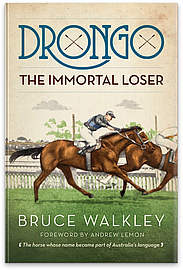 Originally an RAAF term for a raw recruit, derived from the name of a well-credentialled racehorse who could do just about anything…except win a race. He was retired in 1925 after thirty-seven starts led to thirty-seven losses.
Originally an RAAF term for a raw recruit, derived from the name of a well-credentialled racehorse who could do just about anything…except win a race. He was retired in 1925 after thirty-seven starts led to thirty-seven losses.since the 1940s

- drop bear
- a native marsupial
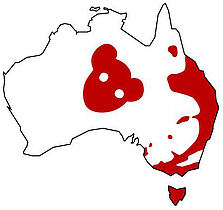 A large, arboreal, predatory marsupial, Thylarctos plummetus, related to the koala.
A large, arboreal, predatory marsupial, Thylarctos plummetus, related to the koala.
Around the size of a large dog, having coarse orange fur with some darker mottled patterning.
A hazard in most cities, towns, and the bush, it appears yearly on 1st April.They hunt by ambushing unsuspecting tourists, dropping as much as eight metres from trees to attack, waiting up to four hours to make a surprise kill.since the 1960s

- drop the kids off at the pool
- a euphemism for defecation
- drum
- reliable news or information
- What's the drum for the next race?
Roughly equivalent to oil. since 1910

- drover
- someone who herds cattle or sheep
- For the drovers life has pleasures, that the townsfolk never know.
clancy of the overflow by a.b. paterson
- dry as a dead dingo's donger
- extremely thirsty
coined by barry humphries in the 1970s

Du
- duck's disease
- shortness of stature
- duck's guts ∼ duck's nuts
- a very good thing
- ducks on the pond!
- female approaching !
- A warning cry that a woman is approaching a traditionally all-male environment.
It is a reminder that men should modify their language and behaviour to avoid giving offence. sunday too far away 1975
First used in shearing sheds, now heard elsewhere, especially in a pub.- duckshove
- to evade a responsibility
- duco
- the paintwork of an automobile
- A trademark registered in 1927, now used generically.
- dud
- 1 a loser
- That guy is an absolute dud.
2 to swindle or cheat - After they left with my money I realised I had been dudded.
3 something that is malfunctioning - Your car is a dud.
- duds
- trousers
- Hang on while I get me duds on.
since the 1920s

- duff
- 1 to steal cattle
colonial australian slang.
2 to make an error - It was an easy putt, but he's duffed it.
3 to be up the duff - To be pregnant.
- dummy ∼ spit the dummy
- have a tantrum
- dumper
- a wave in shallow water
 One which crashes down instead of breaking evenly from the top.
One which crashes down instead of breaking evenly from the top.- dunny
- a lavatory
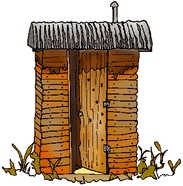
Iconic Australiana, originally located some distance outside the house it served.
Hence To be all alone like a country dunny is to be entirely alone.since the 1840s

- durry
- a cigarette
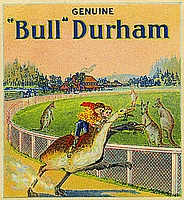 Short for ‘Bull’ Durham, a brand of rolling tobacco, and hence originally a roll-your-own cigarette.
Short for ‘Bull’ Durham, a brand of rolling tobacco, and hence originally a roll-your-own cigarette.
Originally used by the Australian Defence Forces to refer to a rollie, but is now also applied to tailor‑mades throughout the nation. a.d.f. slang first recorded in 1941
a.d.f. slang first recorded in 1941- dust up
- a fight or mellee
 it's the
it's theThe Illustrated Dictionary of
Australian English
Words and Phrases in Afferbeck Lauder